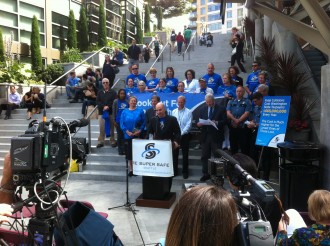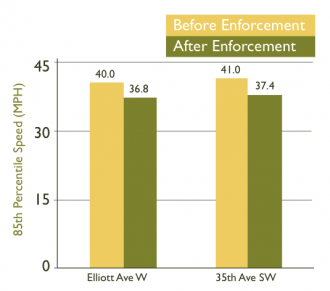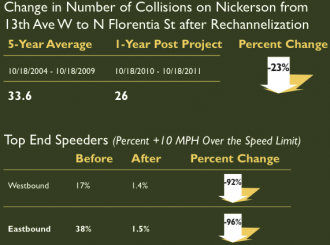 Traffic deaths are preventable. We have the tools and resources to make them stop.
Traffic deaths are preventable. We have the tools and resources to make them stop.
All we need is the will to make it happen.
The city concluded nearly a year of outreach and work to create its first Road Safety Action Plan, which outlines the tools and necessary culture shifts we need in order reach a zero-death reality on Seattle streets. If all of the points in the plan are taken seriously and given the proper resources, it could work, too.
In essence, the report says very little that we didn’t already know. In order to reduce traffic injuries and deaths, we need a combination of education, enforcement, engineering and empathy (they add evaluation to the list of Es). So along with the plan comes a media campaign to teach people the rules of the road and discourage distracted driving and texting.
The plan also includes more targeted emphasis patrols for all road users. However, this process is informed by data showing that by far, the leading cause of collisions between people driving and people on bike and on foot is people driving failing to yield the right of way:

 Evidence suggests that speeding emphasis patrols can slightly reduce average speeds on a roadway. However, the results pale in comparison to safe road engineering projects, like the Nickerson rechannelization.
Evidence suggests that speeding emphasis patrols can slightly reduce average speeds on a roadway. However, the results pale in comparison to safe road engineering projects, like the Nickerson rechannelization.
That project has reduced collisions by an impressive 23 percent. The number of people driving more than 10 mph over the speed limit plummeted more than 90 percent. Most of the collisions prevented were auto-on-auto, so people in cars were the biggest beneficiaries of the changes.
 Basically, here’s where we are: We know how to reduce collisions, and the city is doing so, though at a glacial pace. Meanwhile, the number of people cycling, walking and taking transit continues to climb.
Basically, here’s where we are: We know how to reduce collisions, and the city is doing so, though at a glacial pace. Meanwhile, the number of people cycling, walking and taking transit continues to climb.
We have the means and, now, a clearly stated and data-based goal of making safety our top transportation priority.
For the cost of just the first phase of the Mercer Project, Seattle could have more miles of complete streets with world-class cycle tracks, bus bulbs for transit efficiency and safe crosswalks than Copenhagen. Can you imagine the attention the city would get for being such an inspirational example of ambitious urban investment in safety, sustainability and livability? How many national headlines are we going to get for the Mercer Project?
Add to this the hundreds of millions spent on the Spokane Street Viaduct and the Deep Bore Tunnel (just the city’s portion of the costs), and you can see that we have more than enough money to cure senseless road violence. But we aren’t doing it, choosing other priorities instead.
Now that we’ve gone through this community process, prompted by heartbreaking loss of life on our roads and supported by a data-driven approach, let’s invest some real dollars toward road safety. We might just inspire the nation in the process.
Here’s video of the press conference:
Here’s the full plan:








Comments
17 responses to “City releases plan for zero traffic deaths”
The most serious bicycle injuries I have witnessed in twenty years were:
1. Bicyclist rides off of/down stairs- dies.
2. Two bicyclists on protected bike path, going opposite directions, swerve around a truck that was ALREADY stopped across the intersection; they both continued at speed, did not adjust for limited sight distance, and impacted each other head-on. One bicyclist suffered an aortic aneurysm.
3. Bicyclist riding at night, downhill, in middle of road- hits “rut”, fractures skull (no helmet).
It’s the bicyclists too, not just “other things”.
In the last twenty years only three trees have fallen in the forest…Itfd saw them all.
This isn’t about blame, it’s about identifying what causes collisions and unsafe conditions on the roads and finding ways to solve those problems. It happens that the majority of the time the cause is drivers failing to yield, so that will inevitably be the primary focus, as it should be.
But as the post says, “The plan also includes more targeted emphasis patrols for all road users,” so we should expect to see enforcement of laws for all road users. This is a great step forward for road safety in Seattle; please don’t diminish it with needless (and completely unproductive) finger-pointing.
Shane makes a good point, and I agree with it. I know that personally, it’s when I see others (whether in cars or on bikes) do the most extreme stupid things that I get the most frustrated, even if it’s not directly affecting me.
Why have I not heard about plans for the battery street tunnel once the new deep bore tunnel is completed? It could be used to get cyclist through the city more quickly and in a much safer fashion then is currently the case; particularly if it was connected with a dedicated bike way along the new waterfront.
I believe the plan is to condemn and entomb it. It wouldn’t be a particularly glorious piece of bike infrastructure, but I’d take it, I suppose. Given that Thomas should be reconnected, it might be redundant.
For a matter of balance, a city of any size (such as seattle) needs ways to move high volumes of people and material in and out. This means heavy traffic flows. (I saw an abstract of a study that said if all single occupant car trips were dropped from a city – I think it was LA – total vehicle miles would only fall about 25%.) And as a legal and pratical matter, various people around Seattle have some right to passage through it. The reason for a tunnel rather than a new viaduct is largely about “the view” – but the reality is that’s a high traffic channel the *state* needs, whether Seattle wants it or not. (Witness the state threats to annex the land and build a state highway there if need be.) All of that only partly explains why spending is arranged the way it is, but it helps to be mindful of that explanation.
But perhaps more to the point – the single leading cause of auto related fatalities in the US remains alcohol. We’ve had cyclists, pedestrians, and apparently drunk people sitting the road killed by drunk drivers (at least if we include east side incidents) – all in the last year.
So by all means aim for zero, but don’t be surprized if drunk driving, drunk walking, and I suppose drunk cycling, by themselves, mean it is never reached.
(A few years ago, within the last 10, there was a news story that EVERY road fatality in a local county, Thurston I think, was alcohol related. Not all drivers – drunk pedestrians are an issue too. Very different population density than King County of course.)
And of course, reaching the point where there are NO road (or path/trail/sidewalk) fatalities in all of king county that aren’t at least partly caused by alcohol would be quite an achievement.
I would like to see a link on the 25% stat, that sounds fishy (maybe traffic would drop to 25%?)
And certainly, we need to allow. While travel for the moving of people and goods. None of these solutions would stop these trips. I’m not even saying these big investments are a complete waste of money, just as evidence that we have the money and are not using it on road safety.
As for the causes of collisions, you can see from the graph above that plain old failure to yield is by far the leading cause of collisions involving ppl on foot and bike. Impairment makes the list and is a problem (something addressed by the plan’s PSA projects), but general road errors are the bigger issue, and these can be reduced by safer street designs that remove conflicts and separate modes more.
On the PR aspect of the campaign, it always turns me off and makes me suspicious of the motives and/or intelligence of the promoters of any campaign to get to a “zero” level of anything, when it’s clear to most everyone that’s never going to be possible.
Just as the 10-year campaign to end homelessness is scrambling to figure out how to explain/excuse the campaign’s pretty clear failure when the 10-year period ends in a few years, any such zero-focused campaign is going to end up with people looking at the failure to get to zero, not at the progress that was achieved.
To mention just one unsavory intersection between the campaigns, those people who get killed running across I5 downtown are not likely to be helped by this campaign.
If I find the link again I’ll send it to you. They didn’t claim that traffic or congestion would not drop, they pointed out that total vehicle miles would still be something like 75% of the current vehicle miles. Fewer vehicles doing it, less congestion, but still lots of running miles. (Think of all the delivery and service trucks, all of the buses, etc. Those don’t go away just because commuters do.)
As for causes, you appear to be citing “causes for all sorts of accidents” and I’m thinking of accidents that cause a fatality (which are happily rarer.) Of course, a great many of those are also “failure to yield” as in “failure to yield one half the road way, failure to yield at a stop-light, stop-sign, cross-walk…” etc.
There are a couple important points here.
1. SOV commute VMT are more peaky than other VMT, and we build freeway infrastructure for peak capacity.
2. Generally if we built fewer freeways and didn’t build roads without adequate access for pedestrians and cyclists people wouldn’t choose such long trips so often, which includes carpooling trips, family trips, transit trips, and trips on bike.
It certainly is possible to build functioning cities without the excesses of 20th-century American freeway planning.
I think enforcement would be great, but cops are basically suburbanites who drive muscle cars all day. I’m not optimistic. Just think about the jaywalking ticket/failure to yield ratio.
Freeway planning only exacerbates traffic and produces the systems that increase speed (and anger).
http://dc.streetsblog.org/2011/05/31/study-building-roads-to-cure-congestion-is-an-exercise-in-futility/
Also, as a bike commuter, I’m pretty tired of other cyclists blowing past me to run red lights, and would not resent any reinforcement of that.
[…] what happened: The city held a press conference in South Lake Union announcing the plan and declaring the goal of zero traffic deaths by […]
[…] second time city leaders have gathered press and called for an end to traffic violence. We wrote this story back in […]
[…] deaths and serious injuries. In fact, the Vision Zero is not a comprehensive road safety document like 2012’s Road Safety Action Plan, which set the same goal. Vision Zero Seattle is more like a concrete plan for what the city is […]
[…] Neighborhood Greenways groups in all corners of our city, the Road Safety Summit that crafted our city’s first plan to end deaths and serious injuries, the remake of the Bike Master Plan that lays out the path to […]